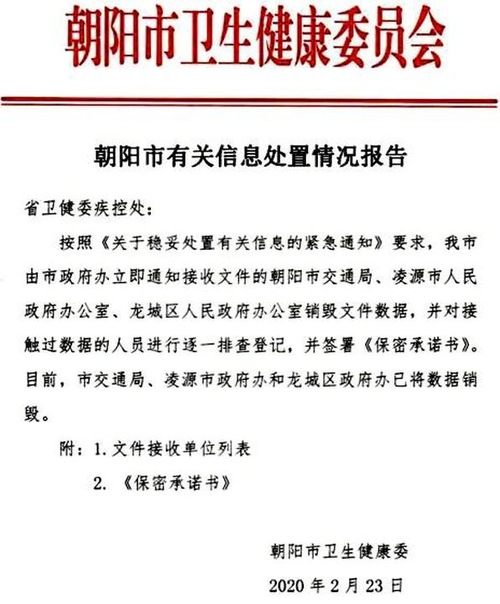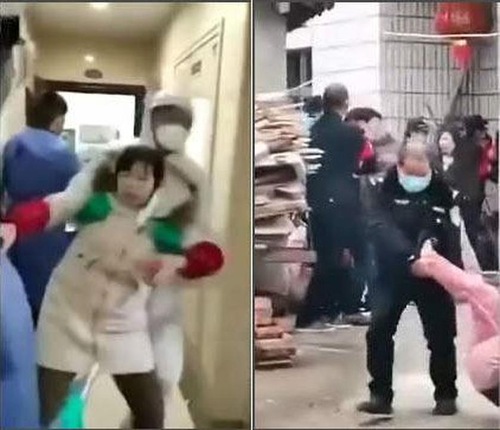The Chinese Communist Party’s Tactics of Evading Responsibility During the Epidemic
(Minghui.org) The ongoing coronavirus pandemic started in Wuhan City, China, in December 2019. After continued cover-up by the Chinese Communist Party (CCP), it has spread to over 80 countries in six continents.
Between the first patient's hospitalization on December 1, 2019 and the lockdown of Wuhan on January 23, 2020, the municipal officials repeatedly informed the public that the disease was not infectious and it was “preventable and controllable,” even after the first patient had infected over 10 healthcare workers and some patients had spread the virus to their entire families. The officials even punished eight physicians and other citizens for raising awareness of the epidemic.
Such cover-ups and misinformation continued after the lockdown of Wuhan. According to Chinese Human Rights Defenders, a non-profit organization based on Washington DC, Chinese officials arrested at least 325 residents between January 22 and 28 alone. Most of them were charged with “spreading rumors,” “creating panic,” or “attempting to disrupt social order.”
As the disease continues to spread across China and other countries, officials blamed each other and shirked responsibility. When the pubic criticized the Wuhan government for not taking effective measures, Wuhan officials said Mayor Zhou Xianwang had provided the information to the national health agency back in December. Top CCP leader Xi Jinping, on the other hand, said he had given instructions on epidemic control and prevention as early as on January 7.
The lack of transparency is rooted in the CCP’s ideology of self-protection and survival. Zeng Guang, chief epidemiologist for CCDC, told Global Times that CCP officials need to consider political factors, social stability, and economic issues and that opinions from scientists are only “part of their decision-making basis.” This explains the CCP's epidemic control strategies. That is, politics has the highest priority, followed by stability and economy. Human life, on the other hand, appears to have little importance compared to these factors.
This report discusses several tactics that the CCP used to shirk responsibility in the out-of-control spread of coronavirus across China and all around the world. These tactics include: covering up and destroying real data on outbreak; redirecting public anger and blaming the U.S. for starting the pandemic; ramping up the propaganda machine to mislead people to believe everything was under control; abandoning victims when they needed the government's help the most, and silencing whistle blowers.
Covering up and Destroying Real Data on Outbreak
Since the lockdown of Wuhan and other cities, officials have been updating the numbers of infected patients and deaths on a daily basis. While the general public considers the numbers reliable data, experts doubt their accuracy. Professor Neil Ferguson, a public health expert at Imperial College, said on January 26, 2020, that his “best guess” was that there were 100,000 infected by the virus even though officials declared only 2,000 confirmed cases at the time.
Ferguson’s team has been modeling the disease for the World Health Organization, and they estimated the virus had a reproductive rate of 2.5-3, meaning that each person infected would potentially transmit it to up to three others. “My best guess now is perhaps 100,000 cases right now,” he said, although it could be between 30,000 and 200,000. “Almost certainly many tens of thousands of people are infected.”
Hu Dianbo, a physician from Hubei Aerospace Hospital in Xiaogan City, Hubei Province, wrote on January 24 that his coworkers in Wuhan also estimated over 100,000 patients.
These high numbers are also consistent with data from cremation. Li Zehua, a former host of China Central TV (CCTV), went to Wuhan on February 16 to investigate the coronavirus outbreak. According to official data, the average number of non-coronavirus-related deaths in Wuhan is 137 per day and the city has a total of 74 crematory furnaces. Li calculated that each furnace would cremate an average of 1.85 (=137/74) bodies per day.
Hankou Crematory, the designated crematory in the city to handle bodies of deceased coronavirus patients, has 30 furnaces, which normally would handle 56 (=30*1.85) bodies of people who died of non-coronavirus-related deaths.
Li also learned that the average number of coronavirus deaths was 40 every day at the time of his investigation. He inferred that Hankou Crematory would have a daily workload of 96 (=56+40) bodies, which would take its 30 furnaces 3.2 hours to finish, given that each body takes about one hour to cremate (note: 3.2*30*1=96). However, Li learned that Hankou Crematory and a few other crematories were hiring people to work non-stop. Assuming Hankou Crematory had its furnaces run for eight hours a day, that would mean they handled 240 (=30*8) bodies, far more than the figure of 96 derived from the official data.
In middle February, about 40 mobile furnaces were shipped to Wuhan. According to Zhou, a resident in Wuhan, these trucks were labeled “processing trash and animal bodies.” Divided into three sections, “solid crushing, burning, and air purification,” “each of these trucks has a capacity of 30 cubic meters (or 40 cubic yards) and can process 5 tons (about 11,000 pounds) of materials every day. Many patients were blocked [by officials] at home and, upon death, their bodies were processed this way,” said Zhou.
 A document from Chaoyang City Health Commission to Liaoning Health Commission dated February 23, 2020, on destroying raw data of coronavirus epidemic
A document from Chaoyang City Health Commission to Liaoning Health Commission dated February 23, 2020, on destroying raw data of coronavirus epidemic
Raw, authentic data has also been deleted to comply with officially published statistics. According to a report issued by Chaoyang City Health Commission to Liaoning Health Commission on February 23, 2020, several government agencies were involved in the data destruction including Chaoyang Transportation, Lingyuan City Government, and Longcheng District Government. “Besides destroying data, officials also identified all individuals who had access to the data one by one, and required them to sign non-disclosure agreements,” wrote the report.
Redirecting Public Anger
Faced with both internal and external pressure, the Chinese regime resorted to redirecting public anger and shifting blame to the U.S.
China’s Foreign Ministry spokesperson Hua Chunying said on February 3 during a press conference that “The US government hasn't provided any substantive assistance to us, but it was the first to evacuate personnel from its consulate in Wuhan, the first to suggest partial withdrawal of its embassy staff, and the first to impose a travel ban on Chinese travelers.” Hua said the US's evacuation of its citizens was “a very bad example.”
What Hua did not say was that, among nearly 1.1 billion yuan donated by foreign firms as of February 2, 2020, the amount from the U.S. businesses was about 280 million yuan, which topped all other nations.
Several days before Hua's press briefing, senior U.S. officials said on January 28 that Beijing had turned down their offer to help fight the epidemic. Health and Human Services Secretary Alex Azar said Beijing had been denying CDC officials’ request to visit China since January 6. In response to this, Hua replied, “Since January 3, we notified the US of the epidemic and our control measures altogether 30 times.”
This remark, however, “generated mockery online [inside China], as Chinese citizens were only made aware of the outbreak after CCTV aired pulmonologist Dr. Zhong Nanshan’s interview on January 20,” wrote a report on Global Voices, adding people were enraged because the CCP leaders had been busy blocking information inside China as well as shirking responsibility.
During the press conference on February 3, Hua also said the U.S. had been “overreacting” and its actions “could only create and spread fear.” Citing data from CDC reports, she said the U.S. flu from 2019 to 2020 had caused 19 million infections with over 10,000 deaths, while the coronavirus had 17,205 infections as of February 2 with a death toll of 361.
But Hua did not mention that China has a much higher flu deaths than the U.S. “over 88,000 deaths caused by flu in China every year,” according to an article published in The Lancet in September 2019 by scientists in Fudan University and titled “Influenza-associated excess respiratory mortality in China, 2010–15: a population-based study.”
Eric Feigl-Ding, a public health researcher at Harvard University for 15 years, said the coronavirus virus Covid-19 is much worse than previous epidemics. It reported to have a rate of infection, R0 (pronounced “R naught”) of 3.8, which means one contagious person will transmit the virus to an average of 3.8 other people. For comparison, the 2009 flu pandemic (also known as swine flu and which led to the deaths of hundreds of thousands) had an R0 of 1.48, and the 1918 Spanish flu (responsible for the deaths of 50-100 million) had an R0 of 1.80. “It is thermonuclear pandemic-level bad... I'm not exaggerating,” commented Feigl-Ding through Twitter on January 25, 2020.
Faking “Everything is Under Control”
As the coronavirus epidemic continued, at least 16 Fangchang Hospitals were established in Wuhan. Also known as square cabin hospitals, these temporary, shelter-like facilities were poorly equipped, which worried medical experts. Yet the media reports highlighted how patients expressed gratitude to the government for having such hospitals in place to treat their symptoms. The danger of the hospitals as described below was not shown on TV.
A 36-year-old man died five days after being discharged from a Fangchang Hospital, reported The Observer on March 6 with a title of “'Recovered’ coronavirus patient dies.” This incident was also reported by Shanghai-based news portal The Paper, but the article was later removed.
An official from Hubei Province CDC said that 14% of discharged coronavirus patients tested positive again days after they left the hospital and that some patients were not tested before being discharged. “...there are too many patients waiting to be discharged, so there's not enough time and doctors to perform all these tests, meaning some patients may be discharged before they've fully recovered,” he said.
Vice Premier Sun Chunlan ordered on February 6 to conduct a door-to-door inspection in Wuhan to identify four types of people: confirmed infection cases and their close contacts, suspected infection cases, and fever cases with inconclusive causes. These people were all taken away to be quarantined. Violence was often involved in the process as people refused to leave their homes.
 Violence was involved during the mandatory door-to-door visit
Violence was involved during the mandatory door-to-door visit
Fever is not the only symptoms of coronavirus infection. According to Wei Peng, such door-to-door inspection failed to accurately identify infected cases. Moreover, as enforcers of the policy went door to door, they could easily spread the disease from household to another.
When Sun and other officials inspected a residential area in Wuhan on March 5, a local resident said what the officials saw during the brief inspection tour was “fake.” Officials also arranged people to pretend to deliver food to them. “It’s fake, everything’s fake!” shouted one woman furiously from her building, whom was soon joined by many others.
Chinese authorities set up a 9-person national coronavirus task force on January 26, 2020. But this team does not include any medical professionals, experts from the National Health Commission, or epidemic control specialists. The goal of this team, comprised only of personnel from the Central Propaganda Department and the Ministry of Public Security, seems not to prevent and provide treatment for the epidemic, but to focus on propaganda, arrest people, and block information.
Abandoning Victims
In contrast to the media reports in China that sang praise of the CCP’s “success” in fighting coronavirus, Baibuting, a community in Wuhan once considered a National Civilized Community in China, found itself being abandoned.
In December 2019, it was already known that the virus could spread from human to human. But Baibuting residents were required to attend an annual feast hosted by Wuhan government on January 18, 2020. A volunteer working the event revealed that he and some community staff members received insider news that Wuhan was to be locked down, but they were told the feast had to go on.
More than 40,000 families prepared a total of 14,000 dishes to share. According to social media posts, many of the dishes had messages singing praises of the CCP. For instance, “Celebrating the 70th Anniversary of China” was written on some of the cakes.
Days later, many in the community began to show symptoms of coronavirus infection. On January 23, the city of Wuhan was locked down.
To reduce the number of reported cases of the coronavirus, officials have now abandoned Baibuting. A netizen wrote on a blogging site, “I am a resident of Baibuting Garden in Wuhan. I write this in despair. At present, Baibuting Garden is in an unmanned situation, with no one in charge. Many people have been infected with this virus. But the leaders in Wuhan gave us only one testing kit per day per grid, which contains about 4,000 families.” The post was soon deleted.
“This is the price we pay for believing in the CCP,” wrote another internet user, Chen Jue.
Muffling Whistle Blowers
As the outbreak worsened in China, the regime's information censorship has also reached a new level.
“Hundreds of keywords and keyword combinations, including ‘Wuhan seafood market’ and ‘SARS variation’ were censored in late December, as doctors sought to warn about the new virus,” reported The Guardian on March 4 in an article with the title of “Chinese social media censoring 'officially sanctioned facts' on coronavirus.”
Even scientific papers were blocked. Zhou Xueguang, a professor at Stanford, discussed top-down decision-making in China in a paper titled “The Institutional Logic of Governance in China: An Organizational Approach.” He wrote, “This is not only an outbreak of a novel virus; it’s also a manifestation of the breakdown of China’s governance structures,” and “The crisis has exposed the cracks in the system.” This article was translated into Chinese and widely circulated online, but it was blocked on the internet within half a day.
Former CCTV anchor, 25-year-old Li Zehua, went to Wuhan to report on the coronavirus outbreak through YouTube. By visiting stores, hospitals, crematoriums, and virology research labs, he searched for information about the coronavirus and the daily life of patients and Wuhan residents.
 Li Zehua, 25-year-old former CCTV anchor, was chased by police for reporting on coronavirus and went missing.
Li Zehua, 25-year-old former CCTV anchor, was chased by police for reporting on coronavirus and went missing.
On February 26, however, Li found himself being pursued by covert police after he visited the biosafety level-4 (BSL-4) lab in Wuhan. These agents then followed him to his home. Prior to his arrest, he live-streamed one final video to viewers, calling for young people to stand up and speak the truth. The live stream was posted on Weibo, a popular Chinese microblogging site, but was later deleted. Li has been missing since then.
“The impact is devastating and the message is clear: If you cross the line, both your business and you will be ruined,” said Bruce Lui, a senior lecturer at Hong Kong Baptist University. “No one can afford to take that risk.”
CCP Glorifies Itself at the Expense of Its People
United Nations Secretary-General Antonio Guterres said on February 24 that the Chinese people are making efforts for all of humanity as they have been sacrificing many aspects of their normal lives to prevent the virus from further spreading.
The outbreak is indeed a catastrophe for the Chinese people. However, once the outbreak is over and the dust settles, the CCP will almost certainly take credit for what the Chinese people have done to stem the pandemic.
As a matter of fact, the CCP has already been praising itself for “winning” the battle against the outbreak. The Propaganda Department and State Council Information Office recently published a new book,“A Battle Against the Epidemic: China Combating Covid-19 in 2020,” in which it celebrates how the CCP, under Xi Jinping’s “heroic” leadership, effectively controlled and managed the spread of the epidemic. Translated versions of the book in English, French, Spanish, Russian and Arabic will be made available in the near future.
The exercise of singing high praises of the CCP has been going on since the CCP's founding. As the propaganda machine cranks up the volume to praise the CCP, it drowns out many tragedies, only a few of which managed to be known to the public.
In Shiyan, Hubei Province, a volunteer temperature-checker stopped by a house on February 24 to find a six-year-old boy open the door for her. The boy said he and his grandpa were the only two residents in the house. She asked to speak to the old man, but the little boy said grandpa had died for several days and he didn't go out because grandpa told him there was virus outside.
The volunteer discovered the old man's body in the bathroom. The little boy had put a blanket on the body. He had been eating crackers in the past few days. Had the volunteer not shown up that day, the little boy may have died just like his grandpa.